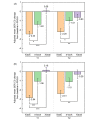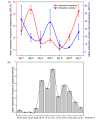Mental Health Chatbot for Young Adults With Depressive Symptoms During the COVID-19 Pandemic: Single-Blind, Three-Arm Randomized Controlled Trial
- PMID: 36355633
- PMCID: PMC9680932
- DOI: 10.2196/40719
Mental Health Chatbot for Young Adults With Depressive Symptoms During the COVID-19 Pandemic: Single-Blind, Three-Arm Randomized Controlled Trial
Abstract
Background: Depression has a high prevalence among young adults, especially during the COVID-19 pandemic. However, mental health services remain scarce and underutilized worldwide. Mental health chatbots are a novel digital technology to provide fully automated interventions for depressive symptoms.
Objective: The purpose of this study was to test the clinical effectiveness and nonclinical performance of a cognitive behavioral therapy (CBT)-based mental health chatbot (XiaoE) for young adults with depressive symptoms during the COVID-19 pandemic.
Methods: In a single-blind, 3-arm randomized controlled trial, participants manifesting depressive symptoms recruited from a Chinese university were randomly assigned to a mental health chatbot (XiaoE; n=49), an e-book (n=49), or a general chatbot (Xiaoai; n=50) group in a ratio of 1:1:1. Participants received a 1-week intervention. The primary outcome was the reduction of depressive symptoms according to the 9-item Patient Health Questionnaire (PHQ-9) at 1 week later (T1) and 1 month later (T2). Both intention-to-treat and per-protocol analyses were conducted under analysis of covariance models adjusting for baseline data. Controlled multiple imputation and δ-based sensitivity analysis were performed for missing data. The secondary outcomes were the level of working alliance measured using the Working Alliance Questionnaire (WAQ), usability measured using the Usability Metric for User Experience-LITE (UMUX-LITE), and acceptability measured using the Acceptability Scale (AS).
Results: Participants were on average 18.78 years old, and 37.2% (55/148) were female. The mean baseline PHQ-9 score was 10.02 (SD 3.18; range 2-19). Intention-to-treat analysis revealed lower PHQ-9 scores among participants in the XiaoE group compared with participants in the e-book group and Xiaoai group at both T1 (F2,136=17.011; P<.001; d=0.51) and T2 (F2,136=5.477; P=.005; d=0.31). Better working alliance (WAQ; F2,145=3.407; P=.04) and acceptability (AS; F2,145=4.322; P=.02) were discovered with XiaoE, while no significant difference among arms was found for usability (UMUX-LITE; F2,145=0.968; P=.38).
Conclusions: A CBT-based chatbot is a feasible and engaging digital therapeutic approach that allows easy accessibility and self-guided mental health assistance for young adults with depressive symptoms. A systematic evaluation of nonclinical metrics for a mental health chatbot has been established in this study. In the future, focus on both clinical outcomes and nonclinical metrics is necessary to explore the mechanism by which mental health chatbots work on patients. Further evidence is required to confirm the long-term effectiveness of the mental health chatbot via trails replicated with a longer dose, as well as exploration of its stronger efficacy in comparison with other active controls.
Trial registration: Chinese Clinical Trial Registry ChiCTR2100052532; http://www.chictr.org.cn/showproj.aspx?proj=135744.
Keywords: COVID-19; chatbot; cognitive behavioral therapy; conversational agent; depression; digital medicine; evaluation; health service; mHealth; mental health; mobile health; randomized controlled trial; young adult; youth.
©Yuhao He, Li Yang, Xiaokun Zhu, Bin Wu, Shuo Zhang, Chunlian Qian, Tian Tian. Originally published in the Journal of Medical Internet Research (https://www.jmir.org), 21.11.2022.
Conflict of interest statement
Conflicts of Interest: None declared.
Figures




Similar articles
-
Effectiveness of a Web-based and Mobile Therapy Chatbot on Anxiety and Depressive Symptoms in Subclinical Young Adults: Randomized Controlled Trial.JMIR Form Res. 2024 Mar 20;8:e47960. doi: 10.2196/47960. JMIR Form Res. 2024. PMID: 38506892 Free PMC article.
-
Chatbot-Delivered Cognitive Behavioral Therapy in Adolescents With Depression and Anxiety During the COVID-19 Pandemic: Feasibility and Acceptability Study.JMIR Form Res. 2022 Nov 22;6(11):e40242. doi: 10.2196/40242. JMIR Form Res. 2022. PMID: 36413390 Free PMC article.
-
Mobile app-based chatbot to deliver cognitive behavioral therapy and psychoeducation for adults with attention deficit: A development and feasibility/usability study.Int J Med Inform. 2021 Jun;150:104440. doi: 10.1016/j.ijmedinf.2021.104440. Epub 2021 Mar 23. Int J Med Inform. 2021. PMID: 33799055 Clinical Trial.
-
Effectiveness of mental health chatbots in depression and anxiety for adolescents and young adults: a meta-analysis of randomized controlled trials.Expert Rev Med Devices. 2025 Mar;22(3):233-241. doi: 10.1080/17434440.2025.2466742. Epub 2025 Feb 16. Expert Rev Med Devices. 2025. PMID: 39935147
-
User Experience of COVID-19 Chatbots: Scoping Review.J Med Internet Res. 2022 Dec 27;24(12):e35903. doi: 10.2196/35903. J Med Internet Res. 2022. PMID: 36520624 Free PMC article.
Cited by
-
Examining the role of AI technology in online mental healthcare: opportunities, challenges, and implications, a mixed-methods review.Front Psychiatry. 2024 May 7;15:1356773. doi: 10.3389/fpsyt.2024.1356773. eCollection 2024. Front Psychiatry. 2024. PMID: 38774435 Free PMC article.
-
The Efficacy of Conversational AI in Rectifying the Theory-of-Mind and Autonomy Biases: Comparative Analysis.JMIR Ment Health. 2025 Feb 7;12:e64396. doi: 10.2196/64396. JMIR Ment Health. 2025. PMID: 39919295 Free PMC article.
-
The Potential of Chatbots for Emotional Support and Promoting Mental Well-Being in Different Cultures: Mixed Methods Study.J Med Internet Res. 2023 Oct 20;25:e51712. doi: 10.2196/51712. J Med Internet Res. 2023. PMID: 37862063 Free PMC article.
-
An Integrative Survey on Mental Health Conversational Agents to Bridge Computer Science and Medical Perspectives.Proc Conf Empir Methods Nat Lang Process. 2023 Dec;2023:11346-11369. doi: 10.18653/v1/2023.emnlp-main.698. Proc Conf Empir Methods Nat Lang Process. 2023. PMID: 38618627 Free PMC article.
-
Effectiveness of AI-Driven Conversational Agents in Improving Mental Health Among Young People: Systematic Review and Meta-Analysis.J Med Internet Res. 2025 May 14;27:e69639. doi: 10.2196/69639. J Med Internet Res. 2025. PMID: 40367506 Free PMC article.
References
-
- Mental Health and COVID-19: Early evidence of the pandemic’s impact: Scientific brief, 2 March 2022. World Health Organization. [2022-05-30]. https://www.who.int/publications/i/item/WHO-2019-nCoV-Sci_Brief-Mental_h... .
-
- Clement S, Schauman O, Graham T, Maggioni F, Evans-Lacko S, Bezborodovs N, Morgan C, Rüsch N, Brown JSL, Thornicroft G. What is the impact of mental health-related stigma on help-seeking? A systematic review of quantitative and qualitative studies. Psychol Med. 2015 Jan;45(1):11–27. doi: 10.1017/S0033291714000129.S0033291714000129 - DOI - PubMed
-
- Holmes EA, O'Connor RC, Perry VH, Tracey I, Wessely S, Arseneault L, Ballard C, Christensen H, Cohen Silver R, Everall I, Ford T, John A, Kabir T, King K, Madan I, Michie S, Przybylski AK, Shafran R, Sweeney A, Worthman CM, Yardley L, Cowan K, Cope C, Hotopf M, Bullmore E. Multidisciplinary research priorities for the COVID-19 pandemic: a call for action for mental health science. Lancet Psychiatry. 2020 Jun;7(6):547–560. doi: 10.1016/S2215-0366(20)30168-1. https://europepmc.org/abstract/MED/32304649 S2215-0366(20)30168-1 - DOI - PMC - PubMed
Publication types
MeSH terms
LinkOut - more resources
Full Text Sources
Medical
Research Materials
Miscellaneous

